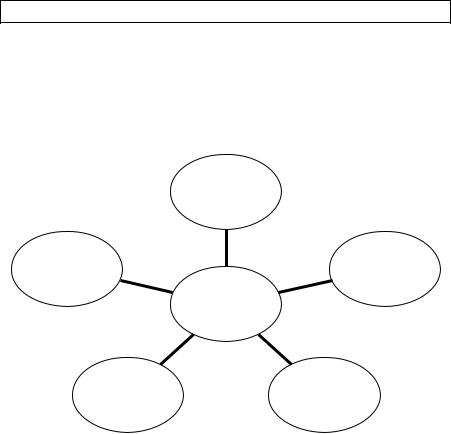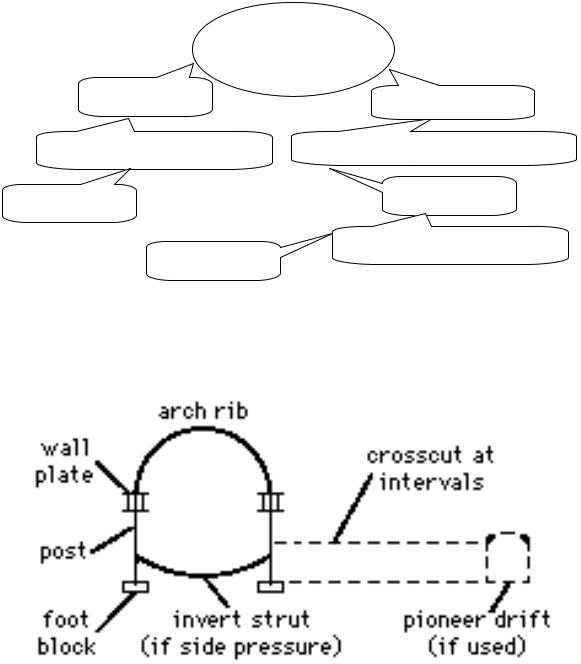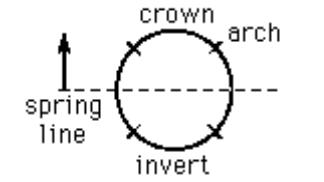
2376
.pdfmeasure the post-tensioning force.
VII. Match the given words with their common and special meanings (consult the dictionary). In what meaning are these words used in Ex. VI?
|
Common meaning |
Special meaning |
|
case |
1) |
тарелка |
a) подмости |
bond |
2) |
эшафот |
b) выпускать облигации |
plate |
3) |
приводить |
c) целиться в летящую птицу |
scaffold |
4) |
связывать |
d) коробка |
lead |
5) |
лицо |
e) поверхность; торец |
face |
6) |
вылечивать |
f) выдерживать |
cure |
7) |
случай |
g) подвергать напряжению |
stress |
8) |
подчеркивать |
h) полоса (металла) |
VIII. Put the following sentences in the correct order to know the process of flexible fabrics application.
Application of sheets (flexible fabrics) would normally require the following steps:
-Remove dirt from concrete surface, round off sharp corners (minimum radius should be in the order of 25-30 mm).
-Apply putty after the primer becomes tack free. After putty application, allowable unevenness must be in the order of 1 mm.
-Primer coating, putty application (optional).
-Mix the epoxy resin and apply it on the concrete surface (undercoating).
-Adhere the fabric.
-Blow or sweep dust off the concrete surface after sandblasting or grinding, dry the concrete (if wet).
-Press using a roller, allow for complete fabric impregnation and apply another coating.
-Protect reinforcement from rain, sand and dust; apply paint (if needed) once the resin is tack free.
-Remove residual resin using a rubber scraper.
Post-strengthening with sheets is best suited for wrapping of columns with a rectangular cross-section. A minimum radius of curvature of approx. 25 mm is required.
Home Exercises
I.Memorize the words from Ex. I page 111.
II. Advertise any composite material you have read about.
123
Text 31
I. Try to translate the following word combinations which are made according to N + N model.
world obstacles; sea currents; boundary dimensions; seabed silt; maintenance costs; bridge supports; weather conditions; railway tunnel; travel time
II. Look at the title of the text. What do you think it is about? Say words you expect to find in the text.
III. Now read the text, check your guesses.
BRIDGE OR TUNNEL
The vast water areas all over the world represent the world obstacles for people’s communication. A man has been striving to subdue water spaces by means of the main road connecting continents, islands, etc. because the economy becomes globolised.
The English Channel separating Great Britain and Europe the Straits of Gibraltar between Europe and Africa, the Bosporus between Europe and Asia, the Bering Strait connecting the Eurasian and American continents, Japaneseislands might offer the missing link for rapid increase land-based transportation to promote improved trade and commerce to facilitate greater economic integration.
Builders always have the choice between bridging and tunneling in crossing over or under a large waterway. Each sort of a structure offers its advantages and shortcomings. One should bear in mind the influence of strong sea currents, great water depth, and large capacity vessels with great boundary dimensions (the under clearance of the bridges must be about 65 m high not to prevent shipping), complicated geological seabed structure. Seabed silt is a rather soft foundation for supports footing. In addition these regions are seismically dangerous and constructional works must provide sufficient strength against seismic waves.
The advantages of the bridge crossing may be the following:
1.Low cost of construction in comparison with a tunnel structure though sometimes it may be quite the opposite.
2.Bridges require lower maintenance costs because tunnels call outlays for water discharging, ventilation, illumination, etc. The longer subaquatic structure is, the heavier outlays are required.
The advantages of the tunnel are:
1.Free shipping is very important under intensive navigation. Tunnels are much safer as compared to the bridge crossing because bridge supports must be
124
calculated for the berthing impact. Being deep beneath the water surface, tunnels do not interfere with navigation. In addition, weather conditions cannot influence the traffic.
2. The architectural view of the tunnel is more attractive because there is no need for high approach embankments.
The final decision for choosing a bridge or a tunnel depends on many factors and not only on technical ones. In some cases bridges are much more preferable. In 1974 the bridge across the Bosporus was erected. In 1985 the bridge crossings connected some Japan islands.
The strait separating Denmark and Europe was also spanned by a bridge. But the choice fell on a tunnel underneath the English Channel. In 1994 the
railway tunnel from Great Britain to France was put into operation. It provides a high-speed rail link with shuttle trains reducing the travel time between the two countries to three-and-a-half hours. Needless to say that the cost of this tunnel is enormous. Another group of Japanese-islands were also connected by the tunnels in 1987.
The problem «a bridge or a tunnel» is being discussed for the type of structures in the nearest future in Italy and across the Straits of Gibraltar and the Bering Strait. The choice falls on a bridge crossing in Europe and on a tunnel for the severe northern conditions.
IV. Fill in the most suitable word.
1.There always was a choice between bridging and tunneling in … over or under a large waterway.
a) crossing b) crippling c) cruising
2.Bridges require lower maintenance … than tunnels.
a) corrosion b) corrugations c) costs
3.Tunnels are much … as compared to the bridge crossing. a) saving b) saver c) safer
4.Weather conditions cannot influence the … through tunnels. a) traffic b) transfer c) transit
5.The cost of the tunnel under the English … is enormous.
a) Cheddar b) Channel c) Canal
V. Read the text once again and find the word that means the opposite of
the word given. |
bound (adj.) _________________ |
gathering _________________ |
|
slow _________________ |
lessening _________________ |
drawback_________________ |
small_________________ |
allow_________________ |
shallow _________________ |
VI. Mark these sentences true, false or not given.
1. ______ The Straits of Gibraltar separates Europe from Africa.
125

2.______ The under clearance of the bridges must be over 60 m high not to prevent shipping.
3.______ For the first time the Bosporus was bridged in 1973.
4.______ Tunnels require lower maintenance costs.
5.______ Vessels can navigate much easier if there are no bridges.
6.______ The Bosporus bridge managed to withstand the wind blows up to 162 km per hour.
VII. Copy the table and complete it using the information from the text and your own knowledge.
bridge tunnel
advantages
disadvantages
Home Exercises
I.Paraphrase the following sentences.
1.The vast water areas all over the world prevent people’s communication.
2.Choosing between bridging or tunneling one should bear in mind many factors.
3.Tunnels are much safer than bridges.
4.The cost of the railway tunnel from Great Britain to France was enormous.
5.The English Channel separates Great Britain and Europe.
6.Every structure offers its advantages and disadvantages.
II. Retell the text using the phrases below for help.
The text is about...; the text deals with the problem of...; it should be noted that...; in comparison with …; it is worth mentioning...; I know that...
Text 32
I. Listen and repeat: |
[I'mq:st |
опускная секция (подводного |
immersed tube |
||
|
'tju:b] |
тоннеля) |
riverbed |
['rIvqbed] |
русло реки |
exceed |
превышать, превосходить |
126
utility |
[Ik'si:d] |
связанный с коммунальными |
|
[ju'tIlqtI] |
услугами |
deal |
[di:l] |
общаться, иметь дело |
submarine |
подводный |
|
bore |
['sAbmqri:n] |
сверлить, бурить |
shield |
[bO:] |
щит |
horseshoe |
[Si:ld] |
подкова |
|
['hO:sSu:] |
|
II. Do you remember bridges classification? Enumerate types of bridges you know.
III. Read about various types of tunnels. Compare indications of tunnels and bridges classification. Are they similar or different?
TUNNELS CLASSIFICATION
Tunnels are underground constructional works driven for transportation purposes including such uses as railroad, rapid transit, highway, pedestrian passages, sewerage, water supply, water power, public utility and canal. There are also immersed tubes. The pipes of great length are laid into a trench in the sea or riverbed and jointed under water. The tunnel length considerably exceeds its cross section. Tunnels are the most complicated engineering works and call for great expenses.
Tunnels classification as well as bridges classification involves several indications.
Indication 1 – by the tunnel function.
1.1.Traffic tunnels. (Much attention will be paid to this kind of tunnel works).
1.2.Mine tunnels. (For mining mineral resources).
1.3.Public utility tunnels. (For public utilities in large cities – water supply and sewerage, electricand telecables).
1.4.Water power or hydraulic tunnels. (For water supply and water discharge).
1.5.Special-purpose tunnels. (For increasing the country defensive capacity). Let’s pay due attention to the traffic tunnels because the students of the
«Bridges and Transport Tunnels» faculty deal with these type of tunnel works. The traffic tunnels may be classified as following:
Indication 1.1 – by the tunnel function.
1.1.1.Railway tunnels.
1.1.2.Motor way tunnels.
1.1.3.Pedestrian tunnels.
1.1.4.Metro tunnels.
1.1.5.Shipping tunnels.
Indication 2 – by the tunnel location. 2.1. Plain tunnels.
127
2.2.Mountain tunnels.
2.3.Submarine tunnels.
The Mersey Tunnel in Great Britain belongs to the longest submarine tunnels and links Liverpool and Birkenhead. The workers began tunneling from the both banks of the river and the breakthrough took place in the middle of the river beneath the riverbed.
Submarine tunnels can be bored through the rock or sometimes they appear to be huge metal tubes resting on the riverbed and having their portals on the opposite banks of the water obstacle.
There are several tunnels beneath the Thames in London which provide railway and foot passages under water. The twin tunnels the Blackwall Tunnel (Southbound) and the Blackwall Tunnel (Northbound), the Greenwich Foot Tunnel and the Rotherhithe Tunnel link the motor ways of the both banks.
Indication 3 – by the construction method.
3.1.Tunnels built by the cut-and-cover method.
3.2.Tunnels built by cutting technique or rock tunnels.
3.3.Shield driven tunnels.
Indication 4 – by the tunnel depth.
4.1.The shallow tunnels (up to 10 m deep).
4.2.The deep tunnels (over 10 m deep).
Indication 5 – by the shape of the tunnel cross section.
5.1.Tunnels of a rectangular cross section.
5.2.Tunnels of a circular cross section.
5.3.Tunnels of a horseshoe shape cross section.
III. Match the English and the Russian equivalents.
pedestrian tunnel |
пешеходный тоннель |
highway tunnel |
тоннель, сооружаемый щитовым способом |
shield driven tunnel |
тоннель, сооружаемый открытым способом |
mine tunnel |
автодорожный тоннель |
cut-and-cover tunnel |
горнопромышленный тоннель |
IV. Use the words in the list to write the opposite of the phrases below. plain, rock, shallow, above-ground, pedestrian, circular
1 deep tunnel ≠ |
4 |
mountain tunnel ≠ |
2 traffic tunnel ≠ |
5 |
cut-and-cover tunnel ≠ |
3 rectangular tunnel ≠ |
6 |
underground works ≠ |
What indication do the tunnels from 1 – 5 refer to?
V. Complete the following sentences. Choose your answers from the box.
128

There are more words than you will need.
1.A tunnel is an underground … for a road or railway through a hill or under a river or the sea.
2.Any soil driven for a tunnel is called …
3.A lining is the … tunnel element.
4.Submarine tunnels can be … through the rock.
5.A portal connects the tunnel with the …
6.Tunnels can be classified according to the shape of the tunnel...
cross-section, rock, basic, ground surface, bored, passage
VI. Look at the following diagram. What is the base of this classification? Can you complete it? Draw a similar diagram in your notebook and let your partner complete it.
Traffic
? ?
Tunnel
Mine ?
VII. Complete the following sentences without looking back at the text.
1.There are several traffic tunnel types. They are …
2.Tunnels for water supply and sewerage, electricand telecables are called …
3.A tunnel laid at 12m depth is called …
4.Submarine tunnels are erected by …
5.Tunnel construction methods are …
VIII. Think of a tunnel and let your friend guess what tunnel it is.
Model:
129

Is it a tunnel for pedestrians?
Yes, it is.
Is it a pedestrian tunnel?
Yes, it is.
Yes, it is.
No, it isn’t.
Is it a tunnel for water supply?
Yes, it is.
Is it a hydraulic tunnel?
IX. Look at the pictures below (fig. 12, 13). Try to describe tunnel shapes. Horseshoe (flat bottom provides roadway)
Fig. 12
Circular (strongest shape)
130

Fig. 13
X. Work in pairs. Speak about the longest railway and highway tunnels of the world using the table below. You may use the following phrases for help:
As far as I know…; do you know what…; what is the longest…; what about…; as far as I remember…; what is its length…; somewhat about…; let me see…
Tunnel |
Location |
Year |
Length |
|
|
completed |
kilometers |
Seikan |
Japan |
1988 |
53.9 |
Channel Tunnel |
United Kingdom-France |
1994 |
50.0 |
Daishimizu |
Japan |
1982 |
22.2 |
Simplon II |
Italy-Switzerland |
1922 |
19.8 |
Simplon I |
Italy-Switzerland |
1906 |
19.8 |
Shin-Kanmon |
Japan |
1975 |
18.7 |
Apennine |
Italy |
1934 |
18.5 |
Saint Gotthard |
Switzerland |
1980 |
16.3 |
Rokko |
Japan |
1971 |
16.3 |
Henderson |
United States |
1975 |
15.8 |
Haruna |
Japan |
1982 |
15.4 |
Furka |
Switzerland |
1981 |
15.3 |
Saint Gotthard |
Switzerland |
1882 |
15.0 |
Nakayama |
Japan |
1982 |
14.9 |
Text 33
I. Listen and repeat: |
['deIlaIt] |
|
daylight |
дневная поверхность |
|
cutting technique |
['kAtIN |
горный способ проходки тоннелей |
tunnel support |
tek'ni:k] |
крепь |
face |
['tAnl |
забой |
adit |
sq'pO:t] |
штольня |
|
|
131 |
shoefly |
[feIs] |
ходок |
calotte |
['xdIt] |
калотта |
vault |
['Su:flaI] |
свод |
central block |
[kq'lOt] |
средняя штросса |
side block |
[vO:lt] |
боковая штросса |
lining |
['sentrql |
облицовка, обделка |
blasting |
'blOk] |
взрывные работы |
charge |
['saId |
заряд взрывчатого вещества |
skip |
'blOk] |
ковш |
|
['laInIN] |
|
|
['bla:stIN] |
|
|
[Ca:G] |
|
|
[skIp] |
|
Find the words you have read in the text below and translate the word combinations having these words. Use the words in the sentences of your own.
II. Work in pairs. Think of 2 or 3 questions using the words from Ex. I. Answer the questions of your partner.
III. Read the following text and say what influences the choice of tunneling technique.
ROCK TUNNELING
A tunnel is an underground way, which passes into a daylight at both ends. To cope with different geological conditions the miners adopt various driving techniques. Cutting is the most ancient technique of tunneling.
The three principal features determine the cutting tunneling technique:
1.The tunnel cross section is divided into several areas which are developed in turns.
2.The lining may be built in the developed sections while the ground may be excavated from the rest of the tunnel face.
3.The temporary tunnel support of timber is used during the tunneling.
The process of the cross section development for hard rock tunneling is as follows. Initially the bottom adit is worked and the temporary tunnel support is built there. Then the vertical and inclined shoeflies are made from the bottom adit. They prepare the top adit or the top drift development.
The next operation to perform is to open the calotte i.e. the development of the top tunnel section. This tunneling stage requires, lining in the tunnel vault. Then the miners excavate the ground from the middle section (central block) and at last in the side sections of the tunnel (side blocks). The ground having been developed, the builders finish the lining erection.
Almost every tunnel job will involve short stretches of bad ground requiring
132
